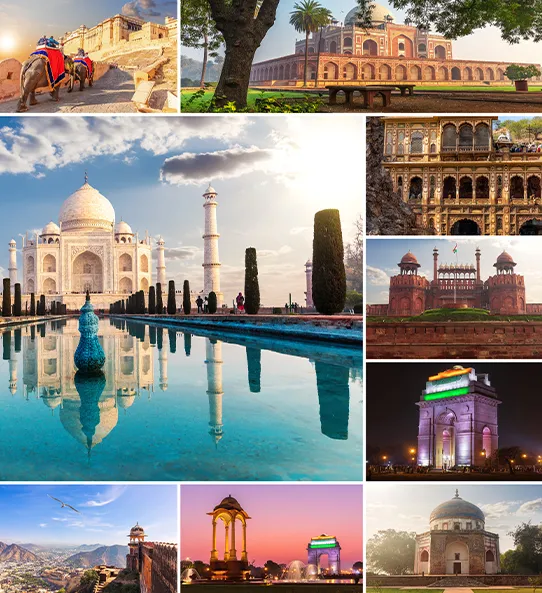We had a great experience with travanya especially with Muskan ma’am who helped us to plan our trip to Bali. Everything became so easy for us to figure out each and every place which was not much overhyped but really beautiful. Also all the visa process and bookings became super easy with the help of Muskan ma’am . Really grateful. Thank you Muskan ma’am.
We booked a Dubai tour with travanA and u must sa this was one of the best vacation of our lives muskan was kind enough to take us through the entire procedure till the very end of the cruise and too top it all was much reasonable than many travel companies would highly recommend travanya for holiday packages
Overall experience is good Rates are reasonable Good support by all team specially my booking person Muskan The cab provided them is very good and always on time Hotels were also good I would like to book my package in future also
We have booked our tour packages from Travanya to Thailand. Muskaan from Travanya did briefed us about the tour and provided all details related to our plan. She was quite supportive and informative. we really enjoyed our trip to Thailand. It was very well organised. It was a great experience and I would definitely recommend it if you want to have a wonderful vacation.
We have enjoyed alot in our Dubai trip with Travanya, all activities were really well organised and driver's were also friendly. Special thanks to Ms. Muskaan for such a well organised plan for us. I thank to whole Travanya team for such a wonderful trip also i will recommend to everyone for their upcoming international tours. Surely i will plan more future plans with you guys.
Hii. May. Name. Shani. Luhar. I. Form inada. Canada. Pass. Potas. The. May. Pasa. Paots. Opan. May. Job. The. Carpnatar. Work. To. The. May. Job.
Wonderful organised trip to Vietnam by Shipra. This was our 5th trip organised by the company and every time we feel relaxed and enjoyed every moment. We thankful to Mr. Rakesh who minutely prepared our Tripp unable us to visit maximum place’s in minimum time.
India is a country that attracts millions of tourists every year and is considered one of the most popular tourist destinations in the world. These visitors are attracted to its natural beauty and cultural heritage. It has many historic sites as well like the Taj Mahal, Golden Temple, Red Fort, etc. With so much to offer, it’s no surprise that tourism is one of the main sources of revenue for the country!
Tourism in India has been seen as a major tool to bring about socio-economic development to the people of the country. India’s tourism industry has grown steadily in recent years. Not only this, India Tourism industry also provides employment opportunities to several people from all parts of the world. There are ample numbers of hotels, resorts, food joints and various other amenities available for tourists arriving in India.
No wonder Tourism is an important foreign exchange earner for India. The Department of Tourism, Ministry of Civil Aviation, Government of India is the apex body for the largest development and promotion of Indian tourism. To promote tourism in India, the government has been implementing a number of campaigns and schemes. These include Incredible India campaign along with a number of planned events such as the International Travel Mart, Destination India Exhibitions worldwide and Indian Cultural Festivals Abroad to attract foreign tourists.
India is a vast country with a lot to offer. Therefore, it comes as no surprise that millions of people pay India a visit every year. The country offers a variety of sights and sounds to enjoy, from the vibrant cities to the peaceful countryside. With its diversity of tourist attractions, India is also known for yoga and meditation. From the snow-capped Himalayas to the tropical beaches of Goa, from the wildlife of Assam to the largest tea field of Kerala, there is something new in every corner of this country. Moreover, with major cities such as Mumbai, Bangalore, Chandigarh, and Delhi being so well connected by air, road, and rail networks from across the globe, it’s easy to get around and explore some of the most iconic landmarks in India.

A country with a rich and colourful history, India is home to some of the world’s most fascinating cultures. India is a country located in South Asia and the capital of India is New Delhi. The Government of India, the Constitutional Republic represents a highly diverse population of thousands of ethnic groups and the many languages spoken in the country.
According to the Population Reference Bureau (PRB), it has a population of over 1.2 billion, making it the second-most populous country in the world. Built-in approximately 9,000 years ago, India was largely self-contained and became a cultural arena associated with Hinduism. The roots of this tradition can be traced to the Indus civilization.
Other religions such as Buddhism and Jainism originated in India, where Buddhism spread throughout Asia, while both religions are quite popular in the subcontinent. India has also developed a rich intellectual life in such fields as astronomy, fine art, architecture, mathematics, and music.
The country has been recognized for its economic development since gaining independence in 1947. It has become the seventh-largest country in the world, and it is geographically distinct from other Asian nations because of its location between mountains and the sea. India is a country of many contrasts, from the Indian Ocean to snow-capped peaks and the deserts in Rajasthan to the green forests of Kerala.
| Official Name: | Bharat (Sanskrit), Republic of India (English) |
|---|---|
| Capital Of India: | New Delhi |
| Population: | 1,210,569,573 (2011 Census) |
| Area: | 3,287,263 square kilometres |
| Geographical Location: | Latitudes 8° 4′ and 37° 6′ North Longitudes 68° 7′ and 97° 25′ East |
| Coastline Length: | 7,516 km |
| Major Religions: | Hinduism, Islam, Sikhism, Christianity, Buddhism, Judaism, Jainism, Zoroastrianism |
| National Anthem: | Jana Gana Mana by Rabindranath Tagore |
| National Song: | Vande Mataram by Bankimchandra Chatterji |
| National Emblem: | An adaptation of the Lion Capital of Ashoka at Sarnath |
| National Animal: | Royal Bengal Tiger |
| National Bird: | Peacock |
| National Flower: | Lotus |
| National Tree: | Banyan |
| National Fruit: | Mango |
| National Currency: | INR () |
| National Sport: | Hockey (Unofficial) |
| Languages: | There are two official languages of the Union Government of India – Hindi and English. |
| National Flag: | The national flag of India is a horizontal rectangular tricolour of India, saffron, white and India green; A 24-spoke wheel, in dark blue colour at its centre, with the Ashoka Chakra. |
India’s history can be broken down into three major phases. The first phase is the ancient period known as Ancient India, which covers thousands of years that began when humans first settled in India. This period includes the Indus Valley Civilization (c. 3300-1300 BCE), which is considered one of the world’s oldest civilizations and a precursor to modern Indian culture.
In medieval India, a period in Indian history is seen as lasting from the ancient period to the Mughal Empire. This long period begins in the 6th century AD and ends in 1526 when the empire was established. Some historians believe that it started later than these dates and ended earlier.
In the early 20th century, India was also experiencing a period of change. In 1857, the Indian independence movement began in Bengal with the first nationalistic revolutionary movement. The British Empire controlled India at this time and it lasted until 1947 when India gained its independence.
India has a rich cultural heritage, reflected in its diverse population. The country’s culture has been shaped by various external and internal influences. Over the centuries, India has seen a significant fusion of Hindus, Muslims, Jains, Sikhs and Buddhists. These religions are collectively known as Indian religions as they originated in India.
“Unity in diversity” – these are words that do not just hold meaning but can be applied to a country like India. From the time of the Mauryas, Cholas and Mughals to the period of the British Empire, India has always been famous for its traditions and hospitality.
Due to warm relations and a sense of celebration, India has a special place in the global community. Its vibrant culture is an amalgamation of religions, festivals, food, arts, crafts and dance. The country is vibrant, and eclectic, and attracts many tourists for its culture. Popularly known as the land of God, the country of India has everything from culture to values, customs and traditions that define its beauty. Also, explore the beauty of Indian Tribes that add colour and beauty to the culture of India.

Monsoon in India: Monsoon holidays are definitely memorable as they offer a wide range of experiences. Monsoons can be relaxing, especially with the cooler temperatures of the rainy season. Contrary to popular belief, the monsoon in India can be a wonderful time to explore this beautiful country. Whether you want to take advantage of Ayurveda in South India or explore some of the natural destinations of India, the monsoon is the best time to enjoy it everywhere in India.

Summer in India: In the summer, you can enjoy pleasant weather while exploring wonderful sights and interesting things to do. India has many tourist destinations for you to visit in summer across the country. You can go to the pristine beaches of Andaman, Goa or Kerala, visit holy places in the high peaks of Uttarakhand, romantic hill stations in India, and so on. For adventure seekers, summer brings excellent opportunities for enjoying various adventurous activities in India!

Winter in India: As the temperature drops, most of the country experiences chilly air that also is a great time to visit in India. The months from November to March are ideal for exploring this wonderful country and enjoying its festivities. Pleasant climate, charming surroundings and variety of activities like snow skiing, paragliding, camping, etc provide a unique holiday experience at the most visited holiday destinations in India.
When planning a trip to India, it is important to consider the costs associated with travelling within the country. Although many people enjoy visiting India for its cultural significance, for some travellers the cost of the trip will vary depending on the activities they do. For an individual, a week in India usually costs INR 17,000 to 18,000. So for two people, a week would cost around INR 36,000. If a couple is planning to travel to India for two weeks, they will spend around Rs 70,000- 72,000 during their India tour. While the price of food in India may vary, the average cost is INR 500-600 per day. Depending on spending habits, an average meal would cost around Rs 200-300 per person and breakfast would be cheaper than lunch or dinner.
The country can be divided into four distinct regions: North, West, South and East. India is both a beautiful and varied country and features many different landscapes. It is a beautiful destination surrounded by cold mountains, dry deserts, vast plains, hot and humid plateaus vast beaches and tropical islands. It is a country that offers something for everyone and every type of tourist. The diversity of the destinations, the ease of access and affordability have made India one of the most sought-after tourist destinations in Asia. Whether you’re looking for magnificent palaces, exotic wildlife or beaches, India has it all. With each region offering unique attractions, there is something for everyone – be it adventure seekers or heritage lovers.
There are so many places to visit in India. Some of them are mentioned below:
The country of India is not only famous for its breathtakingly wonderful monuments but also for its natural beauty in this country. Explore is a land of diversity with numerous tribal groups, languages, religions and exotic cuisines. Travelling abroad is a great experience but nothing like the diversity of landscapes and cultures in India. Working as a leading tour & travel company, we encourage travellers to travel more in India, as our India tour packages introduce travellers to the incredible beauty of the country.
Whether you are planning your honeymoon in beautiful Kashmir or the picturesque islands of Goa, the Travanya India tourism guide will help you choose the best tourist places in India. We are a team of travel professionals who are committed to providing the best travel experience to our clients. We at Travanya spend a lot of time brainstorming, designing and planning holidays in India that are guaranteed to make travelling with us an unforgettable experience.
Answer: The best time to visit India is during the winter season from October through March. This is when the weather is most pleasant, with moderate temperatures and little rain, is the best time to explore the country of India.
Answer: While travelling to India, it is essential that you carry light clothes for summer. It is advisable to pack a sweater or jacket for the winter. And if you are travelling to the southern part of India in the month of August or September, pack a raincoat along with your clothes.
Answer: Traveling with kids can be both exciting and enjoyable, especially when travelling to another country. India is considered safe for tourists and visitors with children, you need not worry about the safety and facilities of children while travelling to India.
Answer: In India, you can use credit cards to pay for hotels, restaurants, and other businesses that accept them. The most accepted credit cards are MasterCard and Visa. American Express is accepted by major hotels and restaurants.
Answer: The Indian Rupee (INR) is the National Currency. Currency exchange is possible at ATMs and Banks that abound in cities but may be difficult to find in small towns, hill stations, or villages.
Answer: It’s easy to find a group of locals who can speak at least basic English in India, or you can hire a tourism travel guide during your vacation.
Answer: India has a maximum of 35 international airports serving both international and domestic flights. Some of the major international airports are located in Delhi, Mumbai, Bangalore, Chandigarh, Kolkata, Goa etc.
Answer: Apart from a valid passport and return tickets, travellers need an Indian visa to enter the country. Electronic visas also come in handy for short recreational trips.
Answer: Yes, it is important to take medical precautions before travelling to India, this will help you have a comfortable journey for your holidays in India. Also, if you are suffering from any disease then it is essential to go through the travel guidelines before planning your trip.
Copyright © 2025 Travanya.com, owned by SHIPRA TRAVELS PVT. LTD. All Rights Reserved.